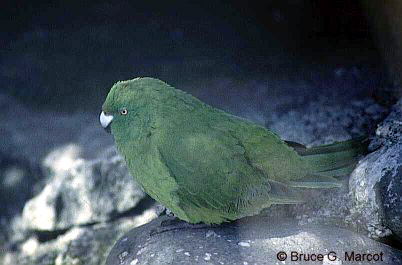 |
|
Rare
Parakeet |
|
|
Click on the image for a larger version
 |
|
Rare
Parakeet |
|
Antipodes Island Parakeet (Cyanoramphus unicolor) |
Credit & Copyright: Dr. Bruce G. Marcot
| Explanation:
This may be one of the coldest parakeets
on Earth. This is the Antipodes
Island Parakeet, which is found on remote Antipodes Island, located
in sub-Antarctic waters south of the main islands of New Zealand.
Only a couple other parakeet species occur on islands slightly further
south.
What makes this parakeet special is that it is endemic to Antipodes Island -- it is found nowhere else in the world. Although a strong flyer, this bird remains isolated on its remote island home. Antipodes Island occurs south of the tropical convergence zone, and thus in sub-Antarctic climate. The island has steep seaward slopes that rise to a central plateau, and is clothed in tussock grass with prickly-ferns (Polystichum) and scattered small Coprosma trees. Most parakeets are secondary or natural cavity-nesters, choosing to nest in tree cavities. Antipodes Island has few trees, no primary cavity-excavator birds to make the cavities, and few natural tree cavities ... so this enterprising parakeet nests in holes in the ground or within the bases of taller tussocks that provide cover. Such is life on a distant island with few resources. Also found on Antipodes Island is the Red-crowned Parakeet of the same genus. Somehow they coexist. One account has the Antipodes Island Parakeet feeding on skins, carcasses, and eggs of penguins killed by skuas (predatory seabirds), as well as leaves, and the more typical parakeet diet of seeds and berries, whereas the Red-crowned Parakeet feeds only on leaves, seeds, flowers, berries, and invertebrates. It seems that the skuas and penguins make the difference for coexistence for the two parakeets. |
Next week's picture: A Tale of Two Echidnas
Member Theme of Taos-Telecommunity